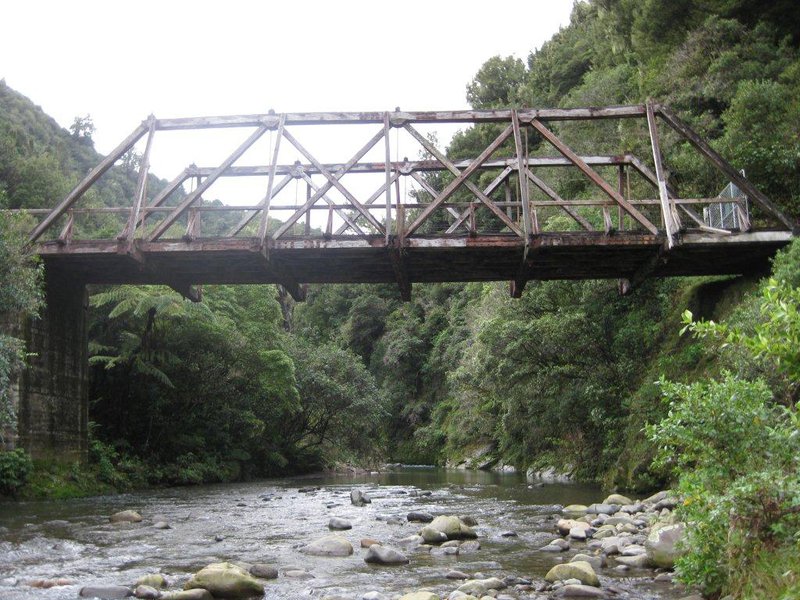Built in 1928, the Manganuku Bridge is one of the few remaining Howe truss bridges in New Zealand. Located in the Waioeka Valley, south of Opotiki, it is a fine example of this once common bridge design.

Manganuku Bridge. Photo: J. La Roche
Waioeka Gorge road
The road through the Waioeka Gorge between Opotiki and Gisborne opened in 1929. The road crosses numerous streams and the Manganuku bridge was one of the last to be constructed to complete the route.
The new road provided a shorter route between the Bay of Plenty and Poverty Bay and better access to farms in the Upper Waioeka. The government had offered these holdings to settlers by ballot, but the land was not suitable for farming and later abandoned. Today the area is part of the Waioeka Gorge Scenic Reserve.
Howe truss design
The Manganuku bridge has a modified Howe truss span of 24.8m and a rolled steel joist land span of 9.5m. A concrete pier near the right bank supports the truss and land span. The deck is 4.7m wide. The bridge was designed and built by the Public Works Department in Australian hardwood.
American, William Howe, patented his truss design in 1840. He used timber diagonals for compression and vertical wrought iron rods to take tension. Thousands of timber truss bridges were built in New Zealand, with Warren truss and Howe truss the most popular designs. Howe truss were favoured for road bridges and were widely used until the 1930s.
Through the second half of the 20th century many timber truss bridges were replaced because of their relatively narrow carriageways and restricted load capacity. Finding suitable timber and skilled carpenters to maintain them had also become a challenge.
Realignment of the road and replacement of the bridge
In 1964 the Waioeka road was realigned, and the Manganuku bridge replaced by one of modern concrete design. The historic Manganuku bridge remained, now isolated a few hundred metres from the main highway where it fell into disrepair.
Restoration
By the early 1990s, the bridge was in a very poor state and in danger of collapse. In 1991, the Department of Conservation commissioned a conservation plan, and with funding from DOC and Transit NZ, repairs were completed the following year. Works Civil Construction undertook the work. Broken beams and rotten timber were replaced, and steel plates used to brace cracked timber.
The bridge was included in Engineering New Zealand’s 1990 heritage project that saw 69 engineering heritage sites recognised with a plaque in celebration of New Zealand’s sesquicentenary. Members of the Gisborne Branch helped to trim back vegetation and to scrape old paint, moss and lichen off the bridge before a timber preservative was applied. The plaque was unveiled at the conclusion of the restoration work in 1992.
DOC led further maintenance and restoration work in 2002 and 2015.
More Information
Heritage recognition
This place has been recognised by Heritage New Zealand as a Category 2 historic place (List number 7197) www.heritage.org.nz/the-list/details/7197
The Manganuku Bridge was recognised by Engineering New Zealand as part of the Engineering to 1990 project.
Further reading
Thornton, Geoffrey. Bridging the Gap: Early bridges in New Zealand, 1830-1939. Auckland: Reed, 2001.
"Bridge Restoration 'just in time'." The Whakatane Beacon, July 23, 1993.
"Manganuku bridge repair underway." Opotiki News, August 13, 1992.
Access
The historic Manganuku bridge provides foot access to the Waioeka Gorge Scenic Reserve and Manganuku Track.
Go to www.doc.govt.nz/parks-and-recreation/places-to-go/east-coast/places/waioeka-gorge-scenic-reserve/manganuku-stream-bridge/
Location
Manganuku Bridge
Page last updated: 09 October 2019



